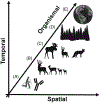The ecology of chronic wasting disease in wildlife
- PMID: 31750623
- PMCID: PMC7085120
- DOI: 10.1111/brv.12568
The ecology of chronic wasting disease in wildlife
Abstract
Prions are misfolded infectious proteins responsible for a group of fatal neurodegenerative diseases termed transmissible spongiform encephalopathy or prion diseases. Chronic Wasting Disease (CWD) is the prion disease with the highest spillover potential, affecting at least seven Cervidae (deer) species. The zoonotic potential of CWD is inconclusive and cannot be ruled out. A risk of infection for other domestic and wildlife species is also plausible. Here, we review the current status of the knowledge with respect to CWD ecology in wildlife. Our current understanding of the geographic distribution of CWD lacks spatial and temporal detail, does not consider the biogeography of infectious diseases, and is largely biased by sampling based on hunters' cooperation and funding available for each region. Limitations of the methods used for data collection suggest that the extent and prevalence of CWD in wildlife is underestimated. If the zoonotic potential of CWD is confirmed in the short term, as suggested by recent results obtained in experimental animal models, there will be limited accurate epidemiological data to inform public health. Research gaps in CWD prion ecology include the need to identify specific biological characteristics of potential CWD reservoir species that better explain susceptibility to spillover, landscape and climate configurations that are suitable for CWD transmission, and the magnitude of sampling bias in our current understanding of CWD distribution and risk. Addressing these research gaps will help anticipate novel areas and species where CWD spillover is expected, which will inform control strategies. From an ecological perspective, control strategies could include assessing restoration of natural predators of CWD reservoirs, ultrasensitive CWD detection in biotic and abiotic reservoirs, and deer density and landscape modification to reduce CWD spread and prevalence.
Keywords: CWD; Cervidae; Chronic Wasting Disease; prions; reservoirs; spread; wildlife; zoonotic.
© 2019 Cambridge Philosophical Society.
Conflict of interest statement
CONFLICT OF INTEREST
C.S. is Founder, Chief Scientific Officer, and majority shareholder of Amprion Inc., a biotech company aiming to commercialize of PMCA and RT-QuIC technologies for highly sensitive detection of misfolded proteins implicated in various neurodegenerative diseases, including CWD. The University of Texas Health Science Center at Houston holds several patent applications related to the PMCA technology which have been licensed to Amprion Inc.
Figures






References
-
- Angers RC, Kang H-E, Napier D, Browning S, Seward T, Mathiason C, Balachandran A, McKenzie D, Castilla J, Soto C, Jewell J, Graham C, Hoover EA & Telling GC (2010). Prion strain mutation determined by prion protein conformational compatibility and primary structure. Science 328, 1154–1158. - PMC - PubMed
-
- Baeten LA, Powers BE, Jewell JE, Spraker TR & Miller MW (2007). A natural case of chronic wasting disease in a free-ranging moose (Alces alces shirasi). Journal of Wildlife Diseases 43, 309–314. - PubMed
-
- Bancroft BA, Han BA, Searle CL, Biga LM, Olson DH, Kats LB, Lawler JJ & Blaustein AR (2011). Species-level correlates of susceptibility to the pathogenic amphibian fungus Batrachochytrium dendrobatidis in the United States. Biodiversity and Conservation 20, 1911–1920.
Publication types
MeSH terms
Substances
Grants and funding
LinkOut - more resources
Full Text Sources

